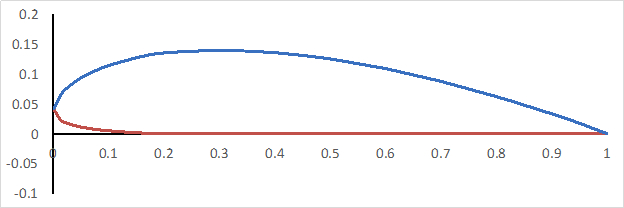Clark Y-14 Wing Performance: Deployment of High-lift Devices (Flaps and Slats)
Source: David Guo, College of Engineering, Technology, and Aeronautics (CETA), Southern New Hampshire University (SNHU), Manchester, New Hampshire
A wing is the major lift-generating apparatus in an airplane. Wing performance can be further enhanced by deploying high-lift devices, such as flaps (at the trailing edge) and slats (at the leading edge) during takeoff or landing.
In this experiment, a wind tunnel is utilized to generate certain airspeeds, and a Clark Y-14 wing with a flap and slat is used to collect and calculate data, such as the lift, drag and pitching moment coefficient. A Clark Y-14 airfoil is shown in Figure 1 and has a thickness of 14% and is flat on the lower surface from 30% of the chord to the back. Here, wind tunnel testing is used to demonstrate how the aerodynamic performance of a Clark Y-14 wing is affected by high-lift devices, such as flaps and slats.

Figure 1. Clark Y-14 airfoil profile.
- For this procedure, use an aerodynamics wind tunnel with a test section of 1 ft x 1 ft and a maximum operating airspeed of 140 mph. The wind tunnel must be equipped with a data acquisition system (able to measure angle of attack, normal force, axial force and pitching moment) and a sting balance.
- Open the test section, and install the wing on the sting balance. Start with clean wing configuration.
- Place a handheld inclinometer on the sting balance, and adjust the pitch angle adjustment knob to set the sting balance
The results of the clean wing configuration are shown in Table 1. Figures 6 - 8 show all three coefficients vs angle of attack, α, for all four configurations. From Figure 6, both the flap and slat enhanced the lift coefficient, but in different ways. Comparing the clean wing and the slat lift curve, the two curves are almost overlapping at low angles of attack. The clean wing lift curve peaks to about 0.9 at 12°, but the slat curve continues to rise to 1. 4 at 18°. This in
Lift generation can be enhanced by the deployment of high-lift devices, such as flaps and slats. Most airplanes are equipped with flaps, and all commercial transport airplanes have both flaps and slats. It is critical to characterize the performance of a wing with flaps and slats during aircraft development.
In this demonstration, a Clark Y-14 wing with a flap and a slat was evaluated in a wind tunnel. The forces and moment measurements were collected to determine the lift, drag and pitching m
- John D. Anderson (2017), Fundamentals of Aerodynamics, 6th Edition, ISBN: 978-1-259-12991-9, McGraw-Hill
Pular para...
Vídeos desta coleção:

Now Playing
Clark Y-14 Wing Performance: Deployment of High-lift Devices (Flaps and Slats)
Aeronautical Engineering
13.2K Visualizações

Desempenho Aerodinâmico de um Aeromodelo: O DC-6B
Aeronautical Engineering
8.1K Visualizações

Caracterização da hélice: variações no passo, diâmetro e número de pás no desempenho
Aeronautical Engineering
26.0K Visualizações

Comportamento do aerofólio: Distribuição de pressão sobre uma asa Clark Y-14
Aeronautical Engineering
20.8K Visualizações

Método da esfera de turbulência: avaliando a qualidade do fluxo do túnel de vento
Aeronautical Engineering
8.6K Visualizações

Fluxo Cilíndrico Cruzado: Medição da Distribuição de Pressão e Estimando os Coeficientes de Arrasto
Aeronautical Engineering
16.1K Visualizações

Análise de bocais: variações no número de Mach e na pressão ao longo de um bocal convergente e convergente-divergente
Aeronautical Engineering
37.7K Visualizações

Imageamento de Schlieren: uma técnica para visualizar recursos de fluxo supersônico
Aeronautical Engineering
11.2K Visualizações

Visualização de fluxo em um túnel de água: observando o vórtice de ponta sobre uma asa delta
Aeronautical Engineering
7.8K Visualizações

Visualização de fluxo com corante de superfície: um método qualitativo para observar padrões de estrias em fluxo supersônico
Aeronautical Engineering
4.8K Visualizações

Tubo Pitot-estático: um dispositivo para medir a velocidade do fluxo de ar
Aeronautical Engineering
48.4K Visualizações

Anemometria de temperatura constante: uma ferramenta para estudar o fluxo em camada limite turbulenta
Aeronautical Engineering
7.1K Visualizações

Transdutor de Pressão: Calibração Usando um Tubo Pitot-estático
Aeronautical Engineering
8.4K Visualizações

Controle de Voo em Tempo Real: Calibração de Sensor Incorporado e Aquisição de Dados
Aeronautical Engineering
10.0K Visualizações

Aerodinâmica de Multicópteros: Caracterizando o Empuxo em um Hexacóptero
Aeronautical Engineering
9.0K Visualizações
Copyright © 2025 MyJoVE Corporation. Todos os direitos reservados